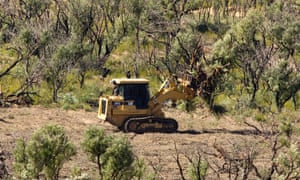Environment groups demand up to date figures to show ‘the full impact’ of the weaker laws
Land clearing in New South Wales rose by more than 50% in 2016-17, the year before the introduction of native vegetation laws that make deforestation easier.
Environment groups are now demanding the government publish up to date figures on the extent of habitat clearing in the state “so the public understands the full impact” of the weakening of land clearing laws in 2017.
Documents obtained by the Sydney Morning Herald under freedom of information laws show that 20,200 hectares of land was cleared for crops, pasture or thinning in 2016-17, up from 13,100 hectares the previous year and at least double the amount for any year between 2009-10 and 2014-15.
Clearing from forestry increased from 21,800 hectares in 2015-16 to 33,500 hectares in 2016-17.
Total clearing, excluding deforestation from fire, rose from 39,000 hectares in 2015-16 to 59,700 hectares.Environment groups are now demanding the government publish up to date figures on the extent of habitat clearing in the state “so the public understands the full impact” of the weakening of land clearing laws in 2017.
Documents obtained by the Sydney Morning Herald under freedom of information laws show that 20,200 hectares of land was cleared for crops, pasture or thinning in 2016-17, up from 13,100 hectares the previous year and at least double the amount for any year between 2009-10 and 2014-15.
Clearing from forestry increased from 21,800 hectares in 2015-16 to 33,500 hectares in 2016-17.
Cobar and Bogan in the state’s central west, Wentworth in the lower Murray and Walgett in the north-west were areas where some of the highest increases were recorded.
“This is more damning evidence that under premier Berejiklian deforestation and land clearing are out of control and rapidly rising, with dire consequences for threatened species like koalas,” Kate Smolski, the chief executive of the NSW Nature Conservation Council, said.
“The scariest thing about this data is that it only represents the two years prior to new land-clearing laws introduced at the end of 2017.”
The NSW environment minister, Matt Kean, said “I understand people care deeply about conserving our natural landscapes – I do too.”
But he said preserving habitat relied on conservation efforts on both public and private land.
“That’s why this government established the NSW Biodiversity Conservation Trust (BCT) in 2017, which is investing more than $350m over the next five years to help protect and conserve our environment, plants and animals,” Kean said.
“In just over a year, the BCT has already invested $55m in 84 new conservation agreements with landholders over more than 19,000 hectares, to conserve NSW’s native plants and animals.”
But Oisín Sweeney, a senior ecologist at the National Parks Association, said the new laws provided for greater intensity of logging, “including in areas that have been protected for decades”.
“It’s therefore highly likely that the impact of logging will become even greater in subsequent report cards,” he said.
“EPA (Environment Protection Authority) data shows that, on average, 20% of logged areas fail to regenerate. So the more forest we log, the more forest we lose.
“Given the context of dual nature and climate crises, the figures again highlight how we urgently need to transition away from industrialised logging and protect our forests to prevent extinctions and store carbon.”
Penny Sharpe, Labor’s acting leader and environment spokeswoman, said the level of clearing was concerning.
“Land clearing impacts not just biodiversity, but soil and water,” she said.
“The government has been caught wanting to loosen the laws without understanding the impact.
“This level of clearing shows they need to take this more seriously and explain how these new laws are not just going to let rip across the state.”

No comments:
Post a Comment